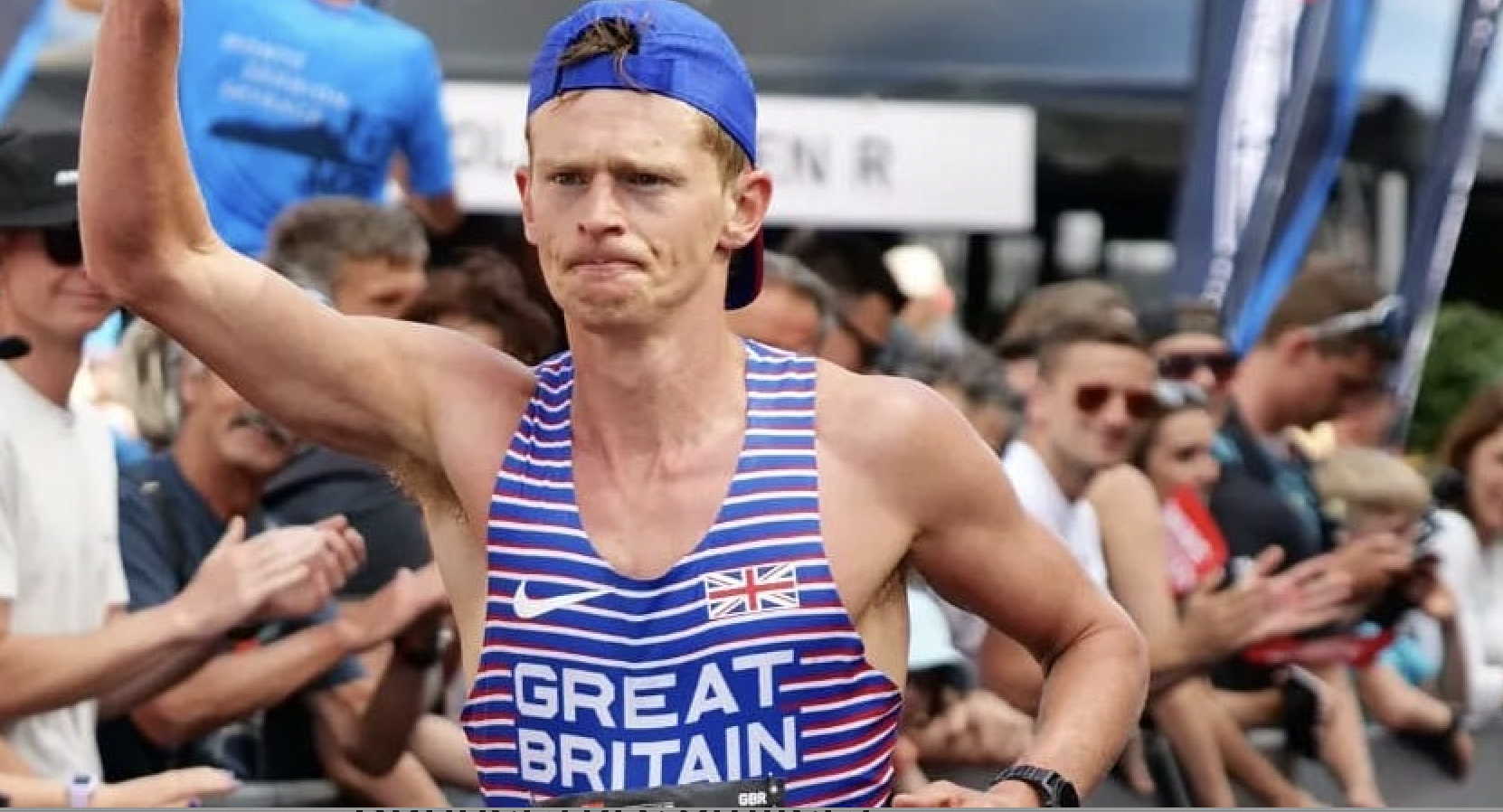Tom Joly de Lotbinere, or Tom Joly as he prefers to be known, was Great Britains top male finisher in the long trail race at the recent World Mountain and Trail championships in Austria. It consolidated his rise over the last two years to be one of Britains top long distance trail runners.I caught up with him to tallk about his World Championship experience.
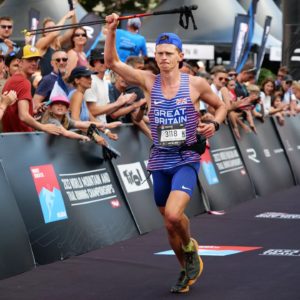
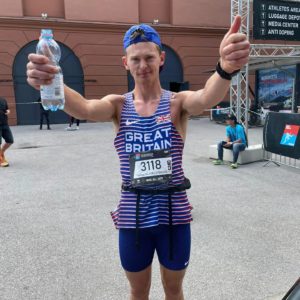
TOM JOLY Finishing a superb 11th place in 10:22:30at the World Mountain and Trail Championships at Innsbruck-Stubai.
Pic WMTRC
Full details of the championships can be found HERE
Full results from the championships are HERE
AS. Just briefly describe any early sporting adventures you had.
Were you sporty at school?
TJ. I was sporty at school, but I was more of an all-rounder. I never made any teams for any sports. Even at cross-country running, I never excelled. My best performance might have been finishing in the top 10 at school. I was “okay” at all sports but nothing special. No real talent anywhere. I just played a lot of sports. I did all the extra sports sessions at school. It was a boarding school, so we got to do things like an assault course, drill squad, biathlon and duathlon, and other extra sports. I would be training in the morning, and then you’d have your rugby, football, hockey, whatever, in the afternoon. I was probably training twice a day from a young age in an unstructured way.
I think that has given me a good base level of fitness. After school, I went to university and did little sport. I did do a lot of drinking and smoking and got very unfit. I realised I needed a goal to get my life back on track.
So I signed up to join the Army. I got even fitter by doing an Ironman triathlon, and then towards the end of my four years in the Army, decided I wanted to enjoy this sporting and athletic life so much, that I wanted to be a professional athlete of some description.
AS. How were you led astray into ultras?
TJ. By an officer in the Scots Guards. He said, “Let’s do a race.” And I said, “Let’s do an Ironman” because triathlon was all I knew.
He said, “Let’s do an ultra marathon “and we ended up running “The Wall” It’s a race along Hadrian’s Wall from Carlisle to Newcastle. It’s about 111 kilometres, 69 miles or so, and we both ran it that first year. I came fifth without much training. I was surprised because I was just aiming to finish. Then I decided to train a bit harder, and the following year came back and won it!
AS. You improved by a couple hours, if not more?
TJ. Yes! Two hours of improvement.
AS.Was there any light bulb moment when you thought, “I could be quite good at this and even aim for a Great Britain team, sometime in the future?” When did that idea get on your radar?
TJ.The Great Britain team thing was a big surprise for me. I was looking at it last year and looking at some of the other athletes who had been on the team. Then trying to gauge where I was compared to them.
If you looked at their ITRA or UTMB scores and indexes, I was a long way off them. I had run a few races and done well, but hadnt really competed against the top British guys. Earlier this last year, I went to Trans-Gran Canaria, which was an unofficial trial race, and managed to come third. I fared very well against some of those other runners.
AS. You have been doing something right over the last year, to get to that next level. You have never really had a coach as such though?
TJ.Yes, that’s correct.
AS.You’re self-coached? Are you totally self-coached? Or do you have people who bounce ideas off occasionally?
TJ. All the programming, coaching and set-up, is all my own experimentation at the moment. I have just linked up with
Team Hour 7 running team. They have experts in several areas, and I should be able to get some Lab Testing to provide feedback data. I also receive support from Inov-8 with shoes, clothing and accessories.
AS. You have been living in Spain for the last year or so?
TJ. I moved out at the start of last year, so I’ve been there for a year and a half.
AS,You’re in a fortunate position where you’re more or less a full-time athlete. Has that helped you to make this improvement? Do you feel that being full-time and having the recovery time between sessions, has helped your progress?
J.T. Hugely. I managed to do 750 hours of training in my last year at work. That was about as much as I could manage while having a full-time job. Then last year, I did a thousand hours of training. On top of that, I was probably getting in an extra 2,000 hours of recovery because I’m on the sofa and eating the extra calories you need.
As an example, as a percentage of that 750 hours last year, maybe I absorbed 80% of the benefits, but with the percentage benefit of a thousand hours, I now absorb maybe 90%,so you’re getting a double compounding effect.
AS. Briefly describe where you are in Spain and how training is there. What sort of training areas have you got to utilise?
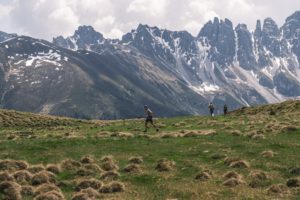
The stunning Mountain Backdrop on the 85 km long trail course in Innsbruck-Stubai, Austria.PIC WMTRC
TJ. I’m right in the south of Spain in the Sierra Nevada mountains. The valley I’m in is the Alpujarra. It’s three and a half thousand meters up to the peaks. There are 20 peaks over 3000 meters. It’s a serious mountain range. Mostly dry, rocky, technical trails, with snow at the top and everything in between. It’s a perfect trail training location.
AS. In terms of how you structure your training, is it all done on trails, or do you do the odd session on a track or road to get some tempo sessions in?
TJ. I do all flat-speed work on the treadmill to reduce the impact and lessen the potential for injury. I do one session a week on the roads, just for the additional specificity of focusing on the intensity and not having to worry about rocks, roots, and whatever else. The rest is all on trails. I used to run on the road all the time. Incidentally, that’s when I found out I got my ankle injury. Whenever I go back to the road to cover any decent mileage, I find it just beats my legs up considerably more than the trail.
AS.So it sounds like you’ve got a good environment where you are training. Describe between the time you were selected in March, and building up to the championships in Innsbruck in early June. Was there any specific training you did with the course in mind, or were you just getting fit?
Also, did you have a chance to look at the terrain and the course?
TJ. I did look at the course. I was more concerned about the altitude. I’ve done a few races where we go up to 3,000 meters in the Sierra Nevada, and I know once I start going above 2,500 meters, everything starts shutting down, as it were. Your heart rate starts dropping rather than going up. I went up to the ski resort in the Sierra Nevada for three weeks before the race and was doing a lot of work in and around the altitude range where the Innsbruck-Stubai course was taking place. Most days, I was between 1800 metres, and 3000 metres when I was training. During those three weeks, I was doing race-specific intensity as well.
I was also running on snow. Incidentally, we were expecting a lot of snow in Innsbruck, but then it heated up and got warm again. The heat became quite a factor on race day, but I felt I had lost all of my heat acclimatizations, from living in Spain.
It was actually then a bit of a shock in Austria.
AS. You seem to cope fine with it. Going into the race in Austria, did you have any goal of where you might finish?
TJ. I had looked on the ITRA start list, they had everyone’s performances. I think I was 30th-ranked. I said that a top 10 would have been a good performance. I would have been disappointed outside of a top 20. I had a good idea of where I thought I could come in. Maybe in the top 10, but I think my result was about right.
AS. The ITRA rankings I’ve always taken it with a pinch of salt. They are a very good guide, don’t get me wrong, and it’s probably the best indicator to gauge and compare people. When you run a road marathon or a road 100k or 24 hours, with a few exceptions, you can compare performances from anywhere more easily. Trail courses are so different that it’s harder to compare one performance against another due to
A, The weather and underfoot conditions.
B, The terrain and elevation of a particular course.
You can look at the elevation over an 80K race, but you and I know that climbs and terrain vary so much from one course to another.
TJ. You are absolutely right. They don’t factor that in.
AS. I’m sure someone’s trying to work on that, but you’re almost playing “Fantasy Athletics.”
TJ. Yes. I suggested to Francesco Puppi, because he has been writing about this, how the index, although a good guide, is not really accurate. .
AS. Exactly. I know. Even for the marathon, it’s hard because the courses vary and conditions vary. It becomes a bigger, almost hopeless task when you get onto off-road events.
Getting back to the championship. You’re there on the start line. Even before that, you’re there at the opening ceremony, and you’re looking around.
What sort of feelings are you having just suddenly being in your Great Britain kit, and there are all these other people in team kit, and you suddenly have that realisation, “Wow, there’s a serious event going on here.
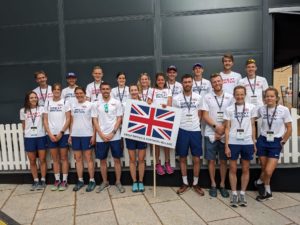
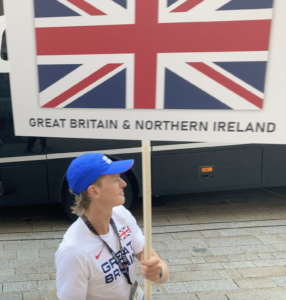
Great Britain & North Ireland Team at opening ceremony in Innsbruck. Tom Joly flying the Flag.Pics Adrian Stott
TJ. Yes. A very serious event. I think I was explaining that my Instagram feed had come to life with all the professional athletes you’ve been following all this time. All of a sudden, you are in and amongst them. I was looking left, right and everywhere and was excited for that week.
AS. Just briefly run through your race from the start. It started early in the morning, at 6.30am. Talk us through how your race unfolded.
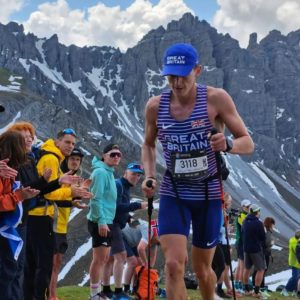
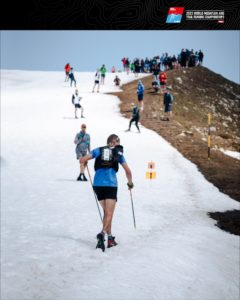
Tom approaching the Half way Checkpoint at Hoadl at 2,300 metres where enthusiastic crowds lined the route. Snow was still lying on the ground on the final climb up to the summit. Pics WMTRC
TJ. The start was a little crazy. Everyone was trying to cram into the pen, and no one wanted to be at the back. It made for quite a hectic start. Once we were all settled, we set off. Everyone was going out at a sensible pace to start with. There was a lot of ducking and weaving to get through to the front or near the front. We knew it would become a single track quite quickly. When you have 300 + athletes, there is always going to be the risk of a pile-up.
I got to the front just in time, as we started hitting the single track. Japanese athletes had shot off fast at this point. I was technically in second. I got my poles out, ready to go on that first climb. As soon as we hit that first climb, the top runners took off. I started dropping back from about 10th, and at the top of the climb, I think I was in about 27th. I was looking at my heart rates and going, this is way too hard.
If I stay with these guys, I’m going to blow up. Harry Jones was just ahead of me. After the first descent, we came into the aid station together. I felt like that was a good place to be. But even on my pacing, we were massively under my schedule. We were going too fast and were about 13 minutes off my plan. Everyone started paying for it from that point onwards. I just held on, and eventually, the field started coming back to me, particularly on the long climb up to Hodel at halfway. That was a two-kilometre climb with a lot of snow near the top. I moved from 20th to 12th and was going to name my favourite athletes. Then, from 12th, at halfway where I saw you at the aid station, I managed to take a few more places, Mostly from people who’d gone out too hard. There was a battle between the Americans and the Swiss athletes. We were all quiet and jostling about, particularly on the last climb. There were five or six of us, all within a minute or two of each other. It was just on the last climb that I felt the wheels start falling off. I slipped back one last place. It was pretty exciting. There is no other race that I’ve been in where you get that depth of field. Even after 10 hours of racing, some of the Americans were winding things up for a sprint finish. Eight minutes were separating fourth and twelfth after 85 km. It was that tight.
AS. It was certainly the best in-depth field you’ve been in to date. Looking at the championship as a whole, there are other big trail races around on the circuit. Where do you feel the World Mountain and Trail Championships sit in the global calendar now?
TJ, It’s still an evolving event.
I think, basing it off the depth of the field, I think, in my opinion, it would probably sit second if you took the average ITRA points. If you took the average index of the top 10, it was over 900, 907 in fact, which might have included Jim ( Jim Walmsley, who although entered, didn’t start) I’m not sure, but again, that’s higher than Western States. UTMB is probably the only race which would still have a big in-depth field, so I would probably rate it second in the world. I don’t think people see it as second in the world yet, as it is still an evolving event.
AS. Coming back to the championships. It’s your first British vest and hopefully the first of many. Who knows what the future holds?
Briefly describe the whole championship experience and being part of it. How did it compare from just going to a race as Tom Jolly, and having to sort everything out yourself, to suddenly being part of a large team of over 30 athletes from various disciplines, and coping with living on top of each other, having fun, and inspiring each other throughout the week?
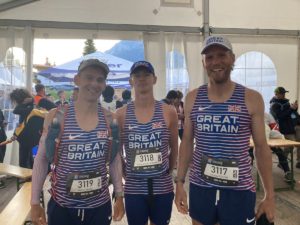
Mens Long Trail team at World Mountain & Trail ChampionshipsL-R Harry Jones, Tom Joly , George Foster. Pic Adrian Stott
TJ. The team aspect was great. You do feel the extra pressure, but you also felt the extra energy of representing your country.
At the opening ceremony, everyone seemed reluctant to carry the flag when we were marching around town, so they handed it to me and I took it quite happily. How often do you get to carry the colours! I found it hugely motivating.
Having team management as well really helped. All of a sudden, a lot of the individual responsibility and stress is taken off your shoulders. So thanks to you, Angela Mark and Anne really. We sit there preparing ourselves, then our bibs and chips arrive and all our extra drinks and snacks for the race, miraculously arrive at feed stations with someone to give them to us too. Being able to rely on your support crew so you can entirely focus 100% on your performance is great.
Probably a big highlight was having the mountain runners with us too. Up to now most of the races I had done have been at the longer end. it just Having top, shorter distance mountain runner’s around you and even going and experiencing their races and cheering them on, that was quite cool. I went to watch the vertical race or the 7k and 1000-metre climb race!. It’s such a diverse sport, and so you get to see that in its entirety.
From the vertical race to the long course what we’re doing is completely different. It almost seems like a different sport, with different skills. You look at the difference between the winner of the vertical Kilometer, the Kenyan, Kipnego or someone similar, and you’ve got a completely different athlete, winning the long course. Body types are all so different. So it feels like a mini off-road Olympics in a way.
AS. Looking back at the championships again, compared to the races like you’ve done before, like Gran Canaria or the UTMB race out in Thailand, do you think it was worthy of a championship? Some people describe the course as just brutal, but would you say it was brutal? Or was it just a good championship course?
TJ. It’s an absolutely world-class test. It was brutal, but I’d say the UTMB Thailand course was actually more challenging in different ways. They had put in some loops, where they sent you on this section which took you off the main trail, had you climb up a bamboo ladder and then brought you back onto the trail. You look back and then realize, you’ve just done an extra 50 meters for no reason. The Innsbruck course was beautiful. There were technical routes, trees, snow, whatever you wanted. It was a course that was worthy of a world championship.
AS. How have you recovered?
TJ. Not particularly well. The combination of three weeks at altitude, picking up a bug in race week, and then racing an intense race took its toll. I am just coming back slowly, and have started training again but nothing intense. I am just doing easy jogs and bike rides.
AS. The big efforts take it out of you, especially if you had a little bug. It didn’t seem to affect your race which went well?.
TJ. It’s hard to tell. Since I had COVID, my heart rate’s been elevated ever since covid. It’s quite hard to read between what’s an illness, what’s fatigue, and what’s lingering effects of COVID.
AS Backtracking for reference, when did you have COVID?
TJ. In December. I didn’t help myself because I ran a race with COVID.
AS. You’re not alone. Many people who’ve had COVID can find even over the next 12 months, it can just affect them a little. Some are worse than others, to the point where they struggle to do anything. Others, like yourself, who do so much, can keep going. Then all of a sudden, you just come to a standstill.
TJ. I think we’re still learning how to deal with it from a sporting angle. It’s just such a weird virus.
.
AS. Looking ahead, you’re obviously recovering now. You alluded already that it’s taken you longer to recover than you thought. Do you think there are any long-term reasons for that?
TJ. I think I did peak in terms of training and race weight. I’m never trying to get my weight down. However, racing back in Gran Canaria, I was 68 plus kilos. In Innsbruck, I was racing at 64 kilos. I think that has quite an effect on the recovery process. I also held an average heart rate of 163 for over 10 hours. I have never done that before, and it is going to have some impact. Then all the excitement from the week, as well as the three weeks altitude beforehand. It’s probably all adding up to create a perfect storm of instability and a little longer to recover.
AS Looking ahead to the rest of the year, what else do you have planned on the calendar? What’s next for Tom in terms of racing?
AS. Well, if I fix my time trial bike that broke the other day, I’ve got a 100-mile road time trial in a couple of weeks. Actually, it is in about 10 days. I am not too serious about it, but it will be fun. After that, I will be building up to UTMB. I am going to France in just over two weeks, after the time trial, and I’ll be there until UTMB on the 1st of September.
AS. Have you been to Chamonix before to train for any extended period? Will that allow you to get used to the course?
TJ. I’ve been a couple of times before but on alpine skis. I have never been in the summer, or seen the trails,
AS. That’s your short-term goal. Looking ahead over the next few years, you’re still relatively new to ultra running, and one hopes you stay fit and healthy for many years. Do you have any long-term goals?
TJ. ( without blinking!) Longer term goal is to win UTMB!
I’d also love to represent Great Britain again, finish on the podium and win a medal. Those are the two big ones I can think of.
AS. Good to see you’re setting your sights very high. That seems like a great place to finish.
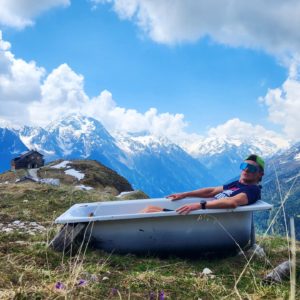
Tom relaxing pre race in a scenic location in a Bath tub:-) Pic Tom Joly
You can follow Tom on Instagram HERE
PLEASE SHARE!
If you have enjoyed this post, do see our other ones HERE
If you are inspired by this or think someone else you know will be, please do what you have to do by sharing. You all know how these things work by now:-) You can also follow me on Twitter and Instagram @tarittweets
